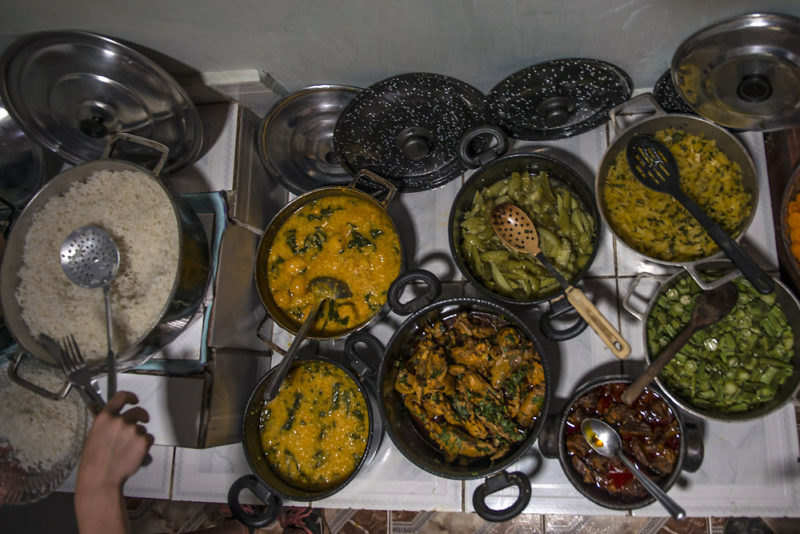The strength and soul of the Jequitinhonha Valley lies in its female population. These women produce beautiful handicrafts by literally taking from the earth in the form of shaping and molding clay with their bare bands. But that is not the only thing that they are known for! They are also some of the best cooks in Brazil, preparing meals that would tickle just about anyone’s taste buds. So let’s talk about gastronomy and in particular Minas Gerais food. You can’t mention region without talking about Minas Gerais food! The region is known throughout Brazil (and the world) for it’s delicious food. If you haven’t heard about it, don’t worry, we’ll walk you through some of the best options, some of which are offered by our hostesses-artisans during the “Do Barro à Arte” itinerary [detailed information on the link! ]. Prepared?
Basically, the prepared dishes take typical ingredients of the region and food influences from other states like Mato Grosso, Goiás and Bahia, bringing together elements with the cuisine of the Midwest and Northeastern. Here are some Minas Gerais food that you need to try:
CHEESE! If you are a cheese-lover then listen carefully! Minas Gerais is the dairy-producing state of Brazil and is known for such cheeses as Queijo Minas, a soft, mild-flavoured fresh white cheese usually sold packaged in water; requeijão, a mildly salty, silky-textured, spreadable cheese sold in glass jars and eaten on bread; and Catupiry, a soft processed cheese sold in a distinctive round wooden box.
Rice with pequi: Rice is the basis of Brazilian cuisine from north to south of the country. Of course there are variations, even more considering the size of Brazil.. But there is no one who has ever eaten a plate of rice, beans, steak, potato chips, and salad, is not it? In this version of the Valley, it is prepared with Pequi, a typical fruit of the Cerrado.
The benefits of its consumption do well for the heart, for the joints, acting as anti-inflammatory, and so on. Only good thing! But good it is even its unique flavor.
Caipira chicken: A chicken that has lived its life running around the yard, what we’d call a free-range chicken, is known in Brazil as a frango caipira, which means country-style chicken. This dish is a Comida Caseira or typical meal that you would eat in the countryside of Brazil.
Farofa de andu: For those who do not know, andu is a type of bean. In English, it is known by numerous names with different etymologies, the pigeon pea, no-eye pea, tropical green pea, gungo pea in Jamaica, arhar in India, red gram, and gandule bean. It is powerful because it is very nutritious and high in protein. In this particular dish, the andu is accompanied by farofa, which is a toasted cassava (also known as yuca, manioc, “mandioca” and Brazilian arrowroot) flour mixture.
Feijão tropeiro (cattleman’s beans): A traditional Brazilian dish from Minas Gerais, Feijão Tropeiro is made with beans, sausage, bacon, collard greens, eggs and and manioc flour.
Carne-de-sol com mandioca: Carne-de-sol, or jabá consists of heavily salted beef, which is exposed to the sun for one or two days to cure. Mandioca is known by many names, some of which include yucca and cassava. This potato-like legume is quite delicious boiled or fried and smothered in butter.
Paçoca de carne: The traditional steak recipe is made with manioc flour and macerated meat with a pestle until a uniform mixture is obtained.
Canjiquinha: This is a dish typically from Minas Gerais, also known as “corn kernel” or “péla mare”. It is basically crushed corn and in the mineira version it is prepared with pork. The appearance is yellowish, creamy and with pieces of meat.
From nature straight to the table: Salads like lettuce, arugula, cabbage and other vegetables are grown in the community and are farm to table fresh! Community members also offer a variety of juices, like orange, lemon, passion fruit and others.
As well as the juices of orange, lemon, passion fruit and others; And fruits such as bananas.
Quitandas: These cakes, biscuits and sweets are usually served as snacks in cafes, and the process that accompanies their preparation is something to experience.
Hmmm … I do not know about you, but we, writing this text, would love be in one of our hostess’s houses right now, ready to be tasting some scrumptious Minas Gerais food. Come with us?






